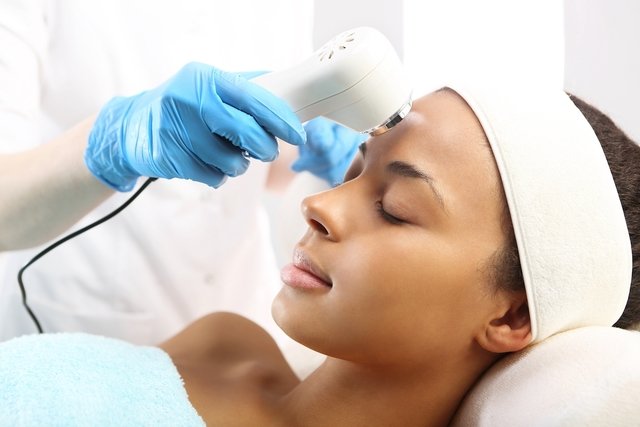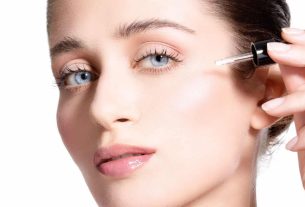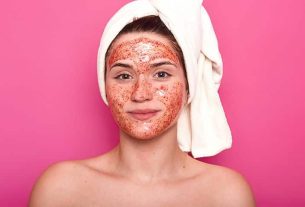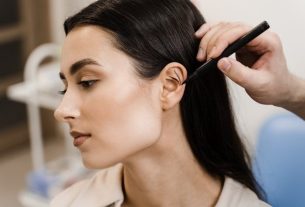Some ways to remove acne scars are the use of creams to apply to the face, or aesthetic treatments, such as dermabrasion, laser, microneedling, peeling with acids, filling the skin with hyaluronic acid or even surgery.
Acne scars can appear due to the deep inflammatory process of the skin, which occurs mainly due to squeezing and squeezing pimples, which can appear on the forehead, cheeks, or chin, being a very common situation that can reduce the person’s quality of life. .
Acne scars do not disappear on their own and, therefore, it is important to consult a dermatologist who can recommend the most appropriate treatment according to the person’s age, skin type and depth of the scar.
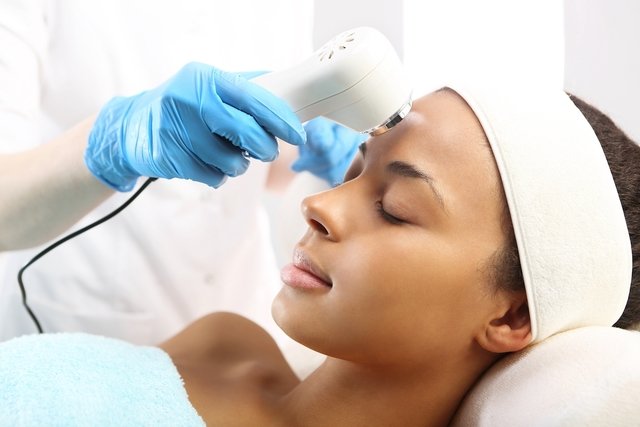
10 ways to remove acne scars from your face
The main ways to remove acne scars from your face are:
1. Creams and medicines to apply to the face
Creams and remedies recommended by your dermatologist, containing salicylic acid, glycolic acid or retinoids, help promote exfoliation and removal of dead skin cells, in addition to stimulating cell renewal and collagen production.
In this way, these creams or remedies improve the texture and reduce blemishes on the skin, making acne scars less noticeable.
In some cases, the doctor may also recommend the use of retinoids in tablet form, such as isotretinoin, for example. Check out the main acne remedies.
When indicated: The use of creams can be recommended for teenagers and young people who still have pimples and blackheads on their face, or have atrophic scars, which are those with a “hole” appearance on the skin.
In addition to the creams or medicines recommended by your dermatologist, it is important to keep your skin clean and hydrated, and apply sunscreen every day to avoid blemishes or new scars on your skin. See how to care for acne-prone skin.
2. Dermabrasion or microdermabrasion
Dermabrasion and microdermabrasion are a type of exfoliation performed by a dermatologist using small equipment with a diamond tip or aluminum oxide crystals, which “sand” the skin by removing its outermost layer.
This increases the production of collagen that gives firmness and support to the skin, and the result is firmer, smoother skin.
This peeling of the outer skin also allows for better entry of acids and creams recommended by the doctor to complement the treatment, although microdermabrasion can also be used alone. See more details about microdermabrasion.
When indicated: dermabrasion is recommended for people who have acne scars, which form small ripples on the face, this being the most common type of acne scar.
The disadvantage is that you have to do the treatment every week and the total treatment time is uncertain. But in any case, this type of exfoliation helps to regenerate the skin, leaving it firmer and the moisturizers penetrate better, resulting in more results.
If you want to undergo treatment to remove acne scars, schedule an appointment with a dermatologist closest to your region:
Taking care of your health has never been easier!
3. Peeling with acids
O peeling with acids, such as salicylic acid, glycolic acid or trichloroacetic acid, is done by the dermatologist, applying the most concentrated acid to the skin to be treated, leaving it to act for a few minutes.
As a result, the skin peels off and a new layer of skin is born, firmer, blemish-free and smooth. The treatment is strong and eliminates even the deepest scars on the skin, permanently.
When indicated: o peeling with acid is recommended for people who no longer have any pimples or blackheads on their face, over the age of 30, which is when the skin becomes more flaccid, making the scars on the face even more evident.
It is an excellent option for those who have many scars on their face, with different depths. The number of sessions required can be a maximum of 15, carried out once a week. See how this treatment is done and what skin care involves.
4. Microneedling
Microneedling is a treatment recommended for removing acne scars, carried out by a dermatologist using a very fine micro-needles device that, when penetrating the skin, causes small wounds, stimulating the formation of collagen. This way, the skin becomes more uniform and smooth.
Microneedling can be done with a roller called DermaRoller, which can also be used at home, or with a pen, called DermaPen. See how microneedling is done.
An advantage of microneedling is that it can also be done at home with the DermaRoller, found in beauty supply stores. However, the results may be better if carried out by a dermatologist.
When indicated: This type of treatment is used for people who have mild or moderate acne scars, who do not have any blackheads or pimples, and who endure the discomfort caused by the needles sliding through the skin.
See how to use the DermaRoller in the following video:
5. Radio frequency
Radiofrequency is a treatment that uses a heat source to stimulate the skin to produce new collagen fibers, leaving it firmer and making acne scars less visible.
Radiofrequency is performed by a dermatologist and may require several sessions at intervals of 15 to 30 days, according to medical advice.
When indicated: This type of treatment is recommended for atrophic acne scars, which have holes in the skin, as by stimulating collagen production, the scar area becomes more “filled” and smoother.
6. Laser
Laser is a treatment carried out with a device that generates a change in collagen fibers, making the skin smoother, progressively eliminating marks and blemishes on the face caused by acne.
In this type of treatment, the professional places the laser on the area to be treated, which will emit some shots that cause a small sensation of heat or burning.
When indicated: This treatment is indicated when cream treatments do not work. Generally, between 3 and 5 laser sessions are required, however, the number of sessions depends on the depth of the marks, and must be guided by the dermatologist.
7. Skin filling with hyaluronic acid
Filling with hyaluronic acid is a treatment carried out by a dermatologist and consists of applying injections to the face in order to remove the fibrosis points that cause the depression that gives rise to the scar, uniforming the skin.
In addition to hyaluronic acid, another skin filler that may be recommended by the doctor is the person’s own fat, which is taken from another part of the body, centrifuged and applied to the scar area.
When indicated: Filling the skin with hyaluronic acid is recommended for people who have acne scars that do not change shape when the skin is stretched and who do not wish to undergo other treatments.
The disadvantage of this type of treatment is that it is not definitive, lasting around 6 months to 1 and a half years, depending on the filler used.
8. Plasma injection
Plasma injection is a type of treatment that consists of applying injections throughout the area to be treated containing the person’s own blood and plasma.
What happens is that when blood is injected into the face, it is not completely absorbed by the skin, resulting in the formation of a clot and the production of new collagen and fibrin fibers, causing the holes in the face to be filled, resulting in skin. firm and uniform.
This treatment must be carried out by a dermatologist and has good results, although it is not very common to use it against acne scars.
When indicated: plasma injection is recommended for people who are not afraid of needles and who cannot undergo another type of treatment.
9. Corticosteroid injection
Corticosteroid injections directly into the acne scar can help remove tall, thick scars, and this type of treatment is carried out by the dermatologist in the office.
In addition to corticosteroids, other injections that can be applied to the scar by the doctor are fluorouracil (5-FU), which is a chemotherapy drug that acts by causing a type of softening of the high scar, leaving the skin more uniform.
When indicated: This type of treatment is recommended for high, raised and thick acne scars, and several applications are generally required to achieve the desired results.
10. Surgery
Acne scar surgery, called subcision, is a type of treatment performed by a dermatologist to remove the fibrous tissue from deeper layers of the skin, responsible for the scar.
In addition to this surgery, other options may be recommended by the doctor, such as puncture excision, in which the doctor surgically removes the scar, with a needle similar to a skin biopsy needle, and then sews the skin together.
When indicated: These surgeries are normally indicated for deeper scars, and the type of surgery to be performed depends on the characteristics of the scar.

Sign up for our newsletter and stay up to date with exclusive news
that can transform your routine!
Warning: Undefined array key "title" in /home/storelat/public_html/wp-content/plugins/link-whisper-premium/templates/frontend/related-posts.php on line 12
Warning: Undefined array key "title_tag" in /home/storelat/public_html/wp-content/plugins/link-whisper-premium/templates/frontend/related-posts.php on line 13

